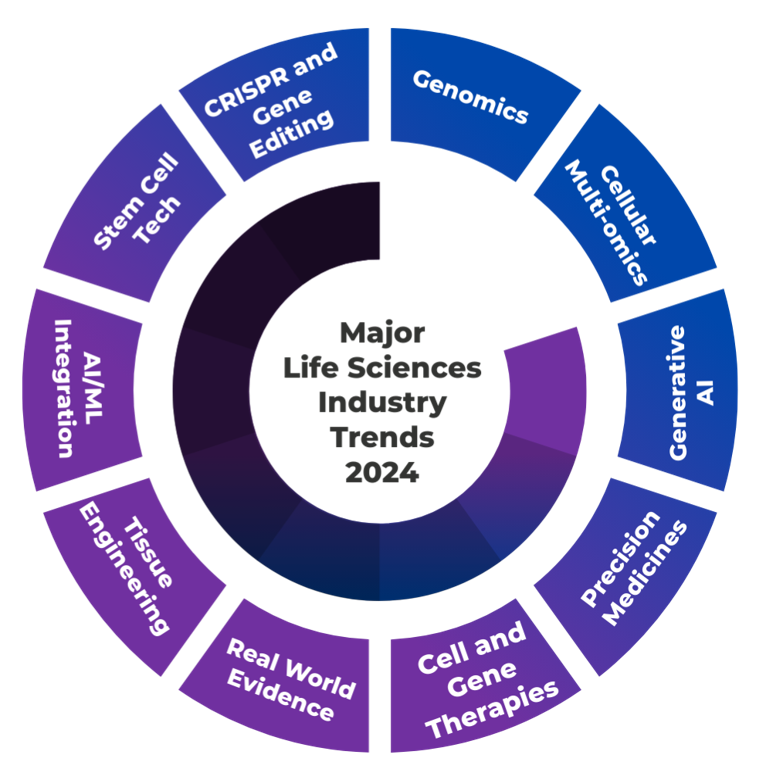2023 was a mixed bag of cookies for the healthcare and life sciences (HCLS) market. The regulatory and funding uncertainties challenged the growth of the biotech and pharma sectors. Au contraire, the rising demand and integration of Generative AI, digital technologies, and virtual reality kept the growth and investment charts alive. Nevertheless, in both cases, significant growth was registered in the last quarter, and further developments regarding healthcare and life sciences can’t be ruled out in 2024-25.
To get a better picture of the global HCLS market, let’s get a bit closer and evaluate major growth indicators: :
Healthcare and Life Sciences: Increased Spending:
The prolonged COVID phase left several backlogs, especially regarding non-covid R&D and innovations. Global investments may have gone up since 2021, but they failed to outpace inflation, putting the SP & Pharmaceutical and SP & Biotech index on a declining slope.
Nevertheless, considerable reduction in interest rates, increased collaborations, and sufficient economic recovery positively impacted market growth, and now the hope is tight and bright that the 2024 healthcare market will show real-time growth and recovery.
Drug Manufacturing Value Chain To Face More Challenges
The impact of cost-control regulations isn’t limited to drug pricing but will now spread through production and market competition. Drug makers are now realizing the IRA in the US and “Pharmaceutical Package” regulations in Europe as they see how it will impact their R&D priorities, supply chain expenses, and ability to face increased market competition.
Drug prices ought to rise in the wake of these challenges, neutralizing the impact of cost-control measures to some extent. Bigger priorities this year will include CRISPR and gene therapies, supporting the dithering supply chains, treating rare diseases, setting up new API manufacturing units, and innovation in oncology regimens.

Figure: Top Life Sciences Trends for 2024
Human Resources and Skillforce Shortages Remain A Challenge
At the beginning of 2023, the healthcare sector was buzzing with talent and workforce shortage on account of COVID aftershocks. Biotech and pharmaceutical companies were worried about the skill level of their workforce, but that seems to have subsided. Yes, it is still an effective tool concerning competitive edge.
On the other hand, the global healthcare segment went through several strikes because of inefficient wage raises, rising inflation, and other pressures. The level of these strikes did go down, but they will continue shaking up the long-term care systems and hospitals at a smaller scale for some time. Globally, companies will try to be more innovative about their recruitment and retention strategies.
Increased M&A Activity Will Be Key To Maintaining Life Sciences’ Services Portfolio
In 2023, a considerable increase in the acquisition of smaller players by their larger counterparts and various mergers was noted. As the major players move forward with new treatments, digitalization, clinical developments, and integration of AI, ML, and mixed reality in their modus operandi, more M&A activity can be expected in 2024-25. As per Stellarix’s estimation, the total valuation of these deals may go as high as $180-190 billion, gaining approx. 27-28% growth on a year-on-year basis.
Healthcare and Sustainability Navigate Each Other’s Ascendence
As the net zero targets of other industries compromise under geopolitics, supply chain disruptions, and the ever-growing demand-supply gap, the healthcare industry braces itself for emission reduction. Besides pharmaceuticals and hospitals, several products like asthma inhalers are under scrutiny. Medical waste, growing heat-caused diseases in equatorial and temperate areas, and tightening protocols on climate-related disclosures are some of the topics that will increase sustainability efforts in this industry this year.
Healthcare and Life Sciences: Final Word
Despite the increase in M&A activity, healthcare spending, and digitalization, a few other concerns remain unanswered. There is very little discussion about emission targets and medical waste management. It is one of the major causes of land and air pollution. Also, the mercury will hit new levels in 2024. It means more diseases, deaths, and increased aid demand in nations close to the equator. Healthcare units will need to build more resilience and inventory to meet such challenges, especially in low-lying regions. A small silver lining is that extra pressure on healthcare systems may give the needed push to digital practices. It includes DCTs, virtual healthcare, telemedicine, speed of vaccine approval process, etc.
The biotech and pharma segments in the life sciences industry are witnessing transformative trends. From CRISPR gene editing to AI adoption and real-world evidence trials, innovation is reshaping the future. Personalized medicines, wearables, and digital health tools drive a patient-centric shift in pharma, while generative AI and digital transformation shape life sciences. Collaboration is key as we navigate challenges like drug pricing pressure. Together, these trends promise a future of ground-breaking discoveries and a more accessible, personalized healthcare landscape.
What’s More?
Yes, there is much more to the development and progress in the healthcare industry in 2024. Discover the impact of Generative AI, ML, gene editing, cloud computing, DCTs, etc., here below: